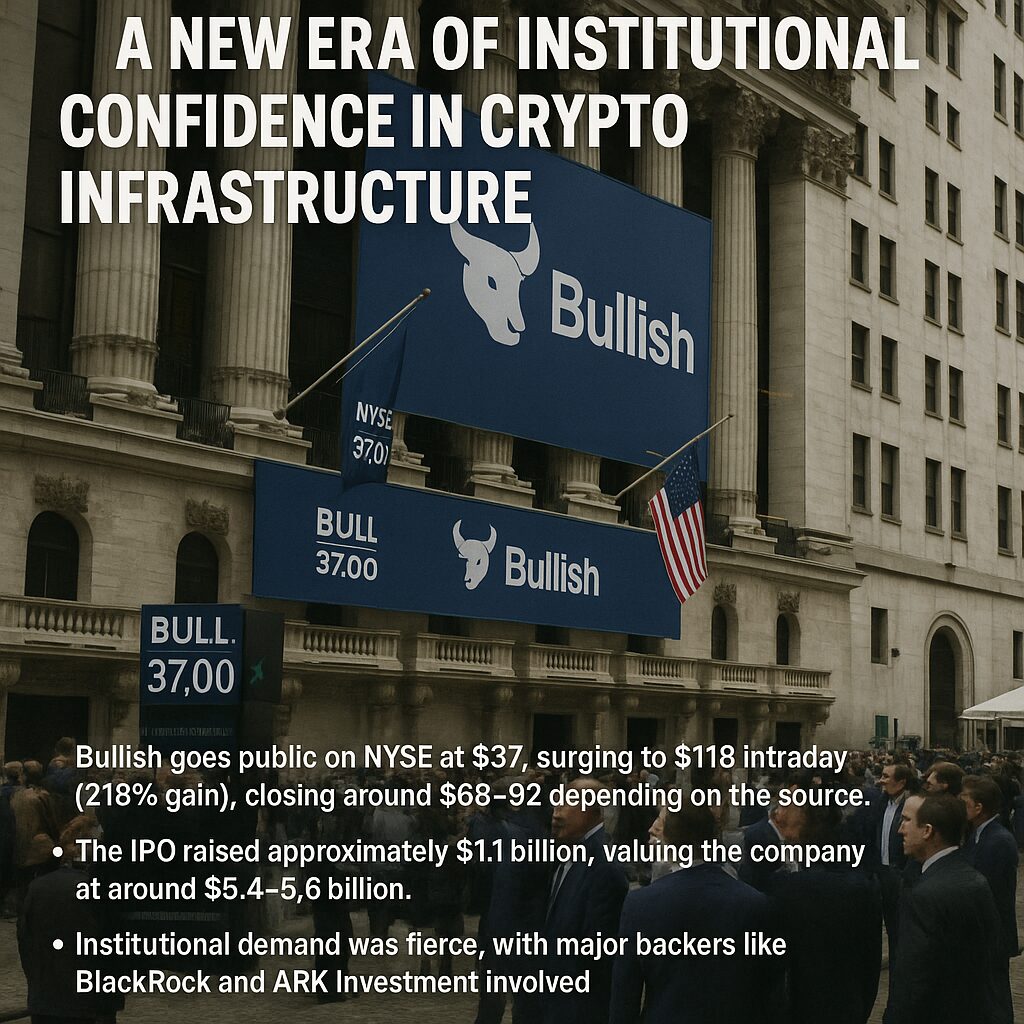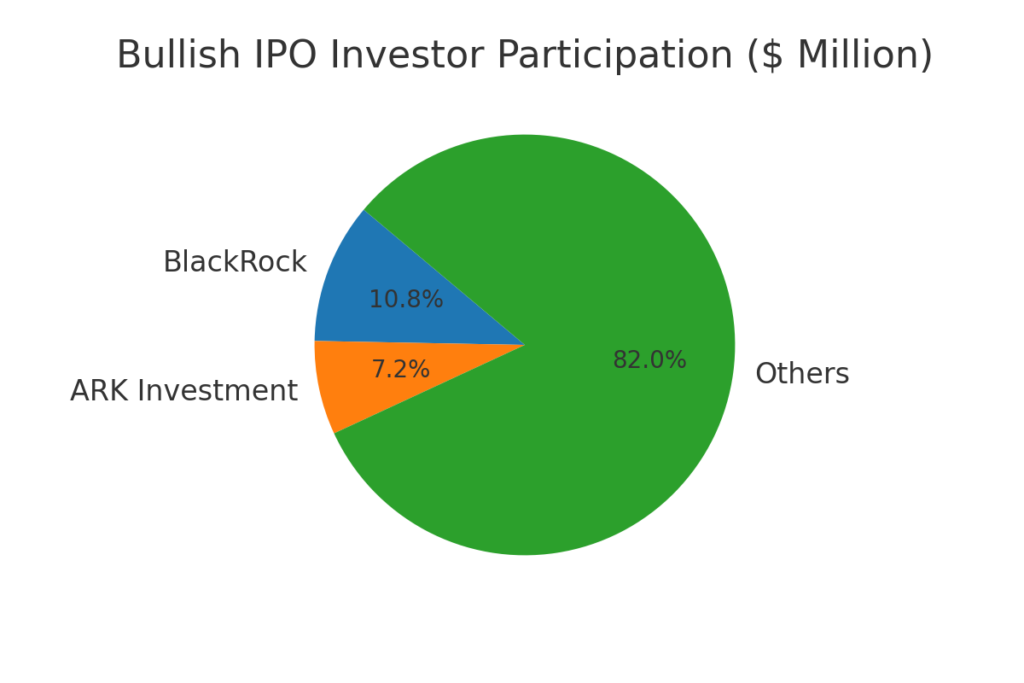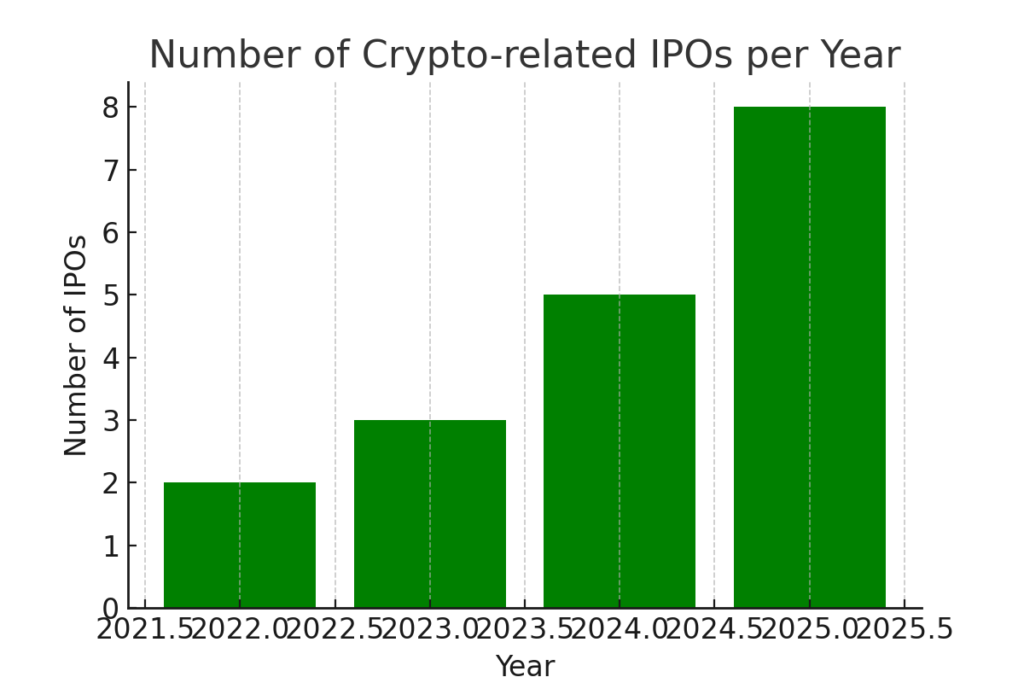
Main Points :
- Bullish goes public on NYSE at $37, surging to $118 intraday (218% gain), closing around $68–92 depending on the source.
- The IPO raised approximately $1.1 billion, valuing the company at around $5.4–5.6 billion.
- Institutional demand was fierce, with major backers like BlackRock and ARK Investment involved.
- Bullish owns CoinDesk, is backed by Peter Thiel, led by ex‑NYSE president Tom Farley, offering regulated infrastructure appealing to institutions.
- The successful IPO reflects a broader climate shift—crypto-friendly regulations, rising mainstream legitimacy, and growing IPO activity in digital assets.
1. A Phenomenal IPO Debut
Bullish, the cryptocurrency-enabled exchange operator and media owner, launched on the New York Stock Exchange under the ticker BLSH through an initial public offering set at $37 per share, exceeding the pre‑IPO target of $32–33. On its first trading day, the stock soared to an intraday high of $118, marking an eye‑popping 218 % increase over the IPO price. By midday, the price still stood around $86, maintaining a roughly 131 % gain and pushing Bullish’s market capitalization to about $13 billion.

At close, however, the stock settled lower. According to one report, it ended at $68, still representing about an 84 % increase over the IPO price. Other sources indicate closing prices near $92. This volatility underscores both the enthusiasm and unpredictability of IPO-day trading.

2. Size and Structure of the IPO
Bullish’s offering consisted of 30 million shares sold at $37 each, raising approximately $1.11 billion and valuing the company at around $5.4–5.6 billion. Originally, the firm had planned to sell around 20.3 million shares in the $28–31 range, targeting a lower valuation of $4.3 billion. Strong demand led the company to upsize the issuance and price — a clear signal of institutional appetite.
High-profile financial giants like BlackRock and ARK Investment Management expressed interest in acquiring up to $200 million worth of shares at IPO pricing. Underwriters included JPMorgan, Jefferies, and Citigroup.

3. Why Bullish’s IPO Resonated with Institutions
Bullish stands out because it is not just a crypto exchange — it also owns CoinDesk, one of the most influential cryptocurrency news and data platforms, which it acquired in 2023 for $72.6 million. The company is backed by renowned investor Peter Thiel (Co‑founder of PayPal), and led by Tom Farley, former NYSE president, reinforcing its credibility.
Moreover, Bullish has built an institutional-grade platform that offers spot, futures, and derivatives trading, with a focus on regulatory compliance and robust governance — attributes increasingly sought by institutional investors. As Peter Kozyakov, CEO of Web3 payments platform Mercuryo, put it, the IPO “reflects clearly heightened institutional demand for crypto-native firms that link digital tokens with the real economy… not hype, but examples of strong governance and infrastructure”.
4. Context: A Broader Resurgence of Crypto IPOs
Bullish’s debut is emblematic of an emerging wave of cryptocurrency and fintech IPOs. This “crypto summer” in public markets has seen companies like Circle, Figma, Galaxy Digital, and eToro go public, while others like Grayscale, Kraken, and BitGo prepare to follow suit.
Contributing to this surge is a more favorable regulatory landscape in the U.S., including potential enactment of legislation like the GENIUS Act, CLARITY Act, and anti-CBDC surveillance laws in Congress that support innovation and adoption. Improved regulatory clarity, combined with institutional demand and renewed investor enthusiasm for crypto assets, has set the stage for a renaissance in crypto IPOs.

5. Risks and Market Realities
While the debut was spectacular, historical patterns suggest caution. Research shows IPOs with high pre‑IPO enthusiasm often enjoy strong short-term gains but underperform in the long run, with first-day returns averaging 29.7%, followed by multi-year declines of –8.2% after adjusting for industry — cautioning investors about overexuberance.
Volatility and regulatory uncertainty remain key risks, even as institutional adoption grows.
Conclusion
Bullish’s NYSE debut — rocketing as high as $118 (218 % above IPO price) and closing between $68 and $92 — signals a resounding vote of confidence from institutional investors in regulated crypto infrastructure. With a $1.1 billion capital raise, support from BlackRock and ARK, and the strategic positioning of owning CoinDesk and led by seasoned leaders, Bullish represents the future of crypto firms gaining mainstream legitimacy. This IPO is a bellwether for the next wave of digital asset companies going public, supported by regulatory tailwinds and surging investor interest. Still, while the initial rally is impressive, investors should stay mindful of potential volatility and the long-term performance dynamics of IPOs.

